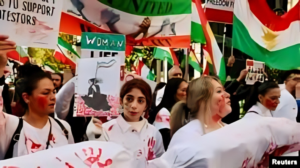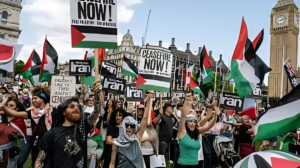Thousands of Iranians Flood Tehran Streets to Denounce US and Israeli Strikes
Introduction
In the wake of recent US and Israeli air assaults on key military and nuclear installations across Iran, an unprecedented wave of public dissent has surged through the heart of Tehran. Over the past weekend, hundreds of thousands of ordinary Iranians—students, families, shopkeepers, and professionals—converged on central avenues, voicing anger at what they perceive as foreign aggression and demanding an end to external interference. Their chants of solidarity and defiance have reverberated from Azadi Square to Enghelab Avenue, marking one of the largest demonstrations in years.

Background: The Triggering Strikes
- Targets Attacked: US and Israeli forces conducted coordinated strikes on June 20–21, focusing on suspected nuclear research centers, IRGC command posts, and military communication hubs located in and around Tehran.
- Casualties and Damage: While official tallies vary, reports indicate dozens of casualties—both military personnel and civilians—and extensive damage to infrastructure, including residential blocks near targeted sites.
- Political Fallout: Supreme Leader Ali Khamenei condemned the strikes as a “blatant violation of sovereignty,” while moderate elements within Iran’s parliament urged measured retaliation to avoid further civilian harm.

The Protest Movement Emerges
Mobilization and Organization
- Grassroots Coordination: Activists leveraged encrypted messaging apps to call for peaceful assemblies, emphasizing national unity over partisan grievances.
- Demographic Diversity: Demonstrators ranged from high school students and university professors to shopkeepers and retirees, underscoring widespread discontent across societal strata.
- Symbols and Slogans: Popular chants such as “No to aggression!” and “Our nation, our rights!” replaced traditional political slogans, signaling a focus on national dignity rather than regime change.
Visual Expressions of Defiance
- Flag Burnings: Small groups ceremonially burned US and Israeli flags at major intersections, capturing global attention and expressing collective outrage.
- Graffiti and Murals: Walls near metro stations were adorned overnight with murals depicting doves breaking chains—an artistic plea for peace and self-determination.

Real-Life Stories from the Streets
- A University Student’s Resolve: Sara, a third-year engineering major, joined the march to demand protection for civilians caught in geopolitical crossfire. She shared, “We study for our future. We refuse to be collateral damage.”
- A Shopkeeper’s Plea: Ahmad, who runs a small bookstore near the protest route, kept his shutters open. “My books bring people together,” he said. “Today’s protest is another story we must read together, not from foreign scripts.”
Implications for Regional Stability
Domestic Politics
- Pressure on Hardliners: The sheer scale of peaceful protest has rattled conservative factions, prompting some clerics to call for immediate dialogue with moderate elements in government.
- Rise of a New Civic Identity: Analysts note the emergence of a “unified Iranian” identity among the youth, cutting across traditional sectarian and ideological lines.
International Repercussions
- Diplomatic Responses: European mediators have urged restraint on all sides, while neighboring Gulf states monitor the situation nervously, wary of spillover effects.
- Potential for Escalation: Military pundits warn that continued air raids could invite reciprocal strikes, risking a broader regional conflagration that might involve major powers.
Conclusion
The mass demonstrations in Tehran illuminate a pivotal moment in Iran’s modern history: ordinary citizens asserting their voice against actions they deem unjust, regardless of the source. Amid chants for sovereignty and unity, a new chapter is being written—one where public sentiment may shape not only domestic policy but also Iran’s posture on the world stage. As negotiations and back-channel talks intensify, the message from the streets is clear: Iranians demand peace, respect, and an end to external meddling.